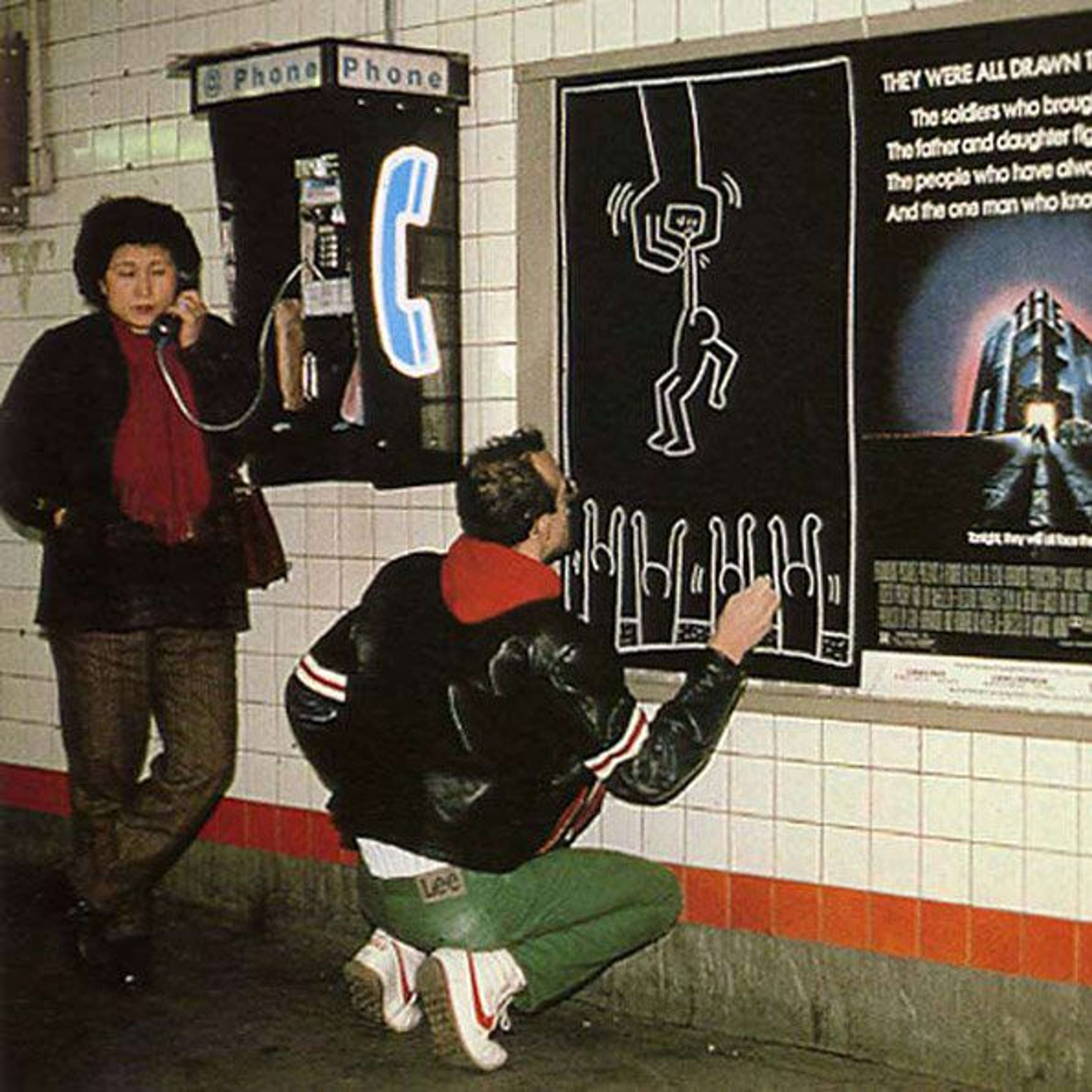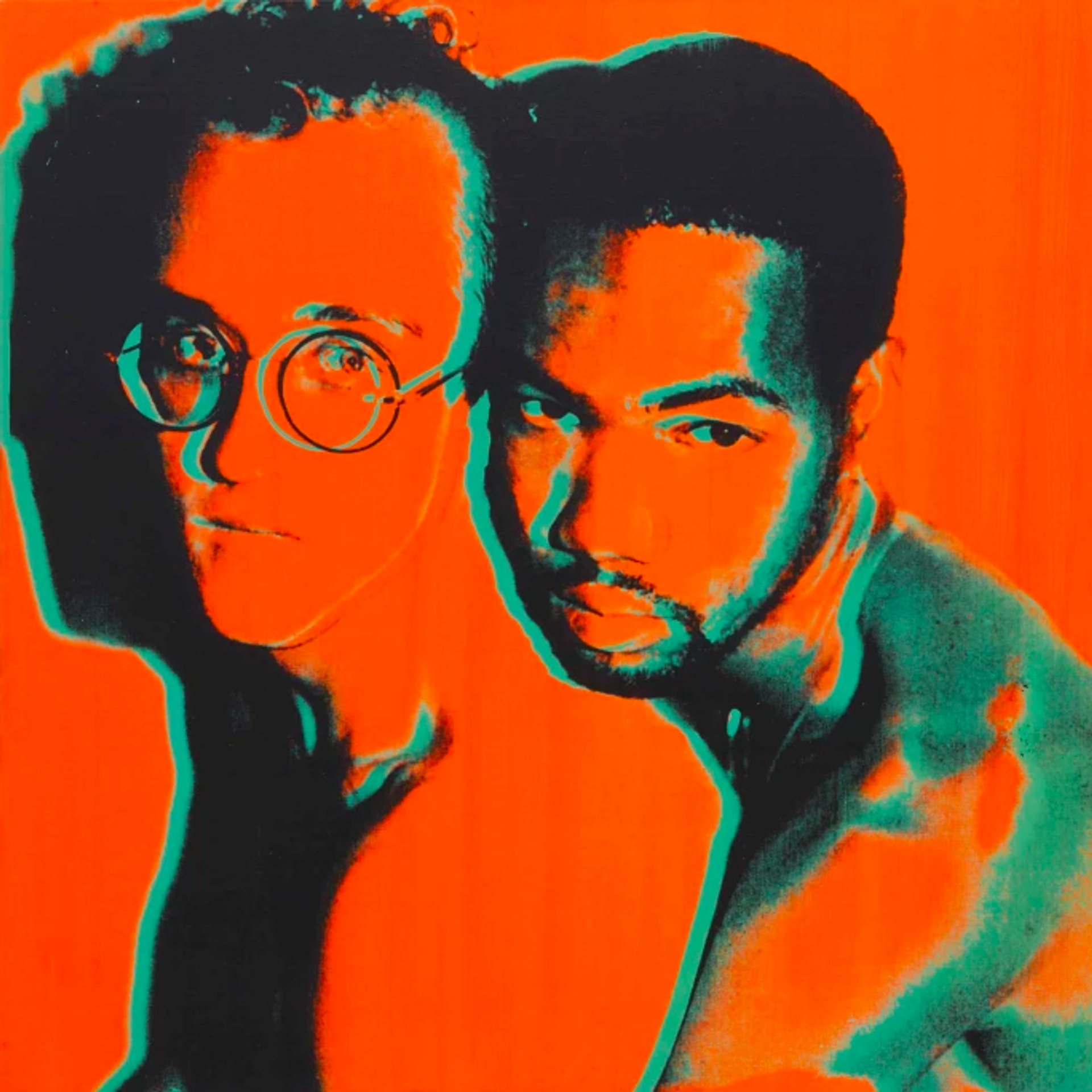Iconography and Activism: The Dual Nature of Keith Haring’s Icons

 Flying Devil © Keith Haring 1990
Flying Devil © Keith Haring 1990
Interested in buying or selling
Keith Haring?

Keith Haring
250 works
In the history of modern art, few artists have managed to seamlessly blend iconography with activism as effectively as Keith Haring. Standing testament to this fusion is his Icons series, offering a narrative that weaves together playful visual symbolism with a strong activist message.
 Image © Creative Commons via Flickr / Keith Haring In The Subway 1983
Image © Creative Commons via Flickr / Keith Haring In The Subway 1983Haring's work, characterised by its dissemination and widespread application, stands as a testament to the power of visual communication in contemporary art. Haring’s distinctive motifs resonate with the force of universally recognised symbols, akin to other emblematic figures of popular culture. These symbols, which Haring aptly named ‘icons’, include the sharp barking dog, the crawling infant, the yellow angel, and the winged red devil. These icons not only represent Haring's unique visual language but also serve as a bridge between art and the public space.
Haring's dedication to creating these icons reflects a deep understanding of their power in the “merchandise circus” of popular culture. His icons go beyond just artistic expression, embedding themselves as socio-political critiques of the 1980s. This is evident in two of his graphic series dedicated to these icons: one vibrantly coloured and another, the White Icons, devoid of colour. The contrast between these series highlights Haring's versatility in using colour - or the absence of it - to evoke different emotional responses while maintaining the potency of his symbolic language.
Each icon, through its simplicity and immediate recognisability, becomes a vehicle for Haring's commentary on societal issues. From advocating for LGBTQ+ rights to raising awareness about the AIDS crisis, Haring used his icons as tools for change, embedding deeper meanings within their seemingly playful forms. This dual nature of Haring’s work - combining the allure of iconography with the urgency of activism - cements his legacy as an artist who not only captured the context of 1980s America but also used his art as a catalyst for social change.
Radiant Baby
The Radiant Baby is one of Haring’s most celebrated symbols. Depicting a child encircled by rays, this emblem stands as a powerful representation of innocence and hope in the purest form of human existence. The emanating rays invoke religious undertones, aligning the image with historical representations of the Christ Child and drawing a parallel with religious iconography.
In the early stages of his career, Haring adopted the Radiant Baby as his signature 'tag', causing the symbol to become synonymous with his identity as an artist and causing his work to be instantly recognisable. Often juxtaposing the Radiant Baby with elements and surroundings that were decidedly more sinister, Haring created a contrast that highlighted the loss of innocence in modern society. This interplay between the purity and optimism of the child and the complex realities of the world underscores Haring's keen awareness of societal issues.
Through this dichotomy, Haring effectively communicated the tensions and contradictions inherent in the human experience. In its simplicity, the Radiant Baby serves as a beacon of purity amidst the chaos and corruption of the world. It is a poignant reminder of the inherent goodness and potential within humanity, set against the backdrop of a society grappling with its own moral and ethical dilemmas. Haring's masterful use of this symbol simultaneously captures his visual language and profound social commentary.
Angel vs Devil
The interplay of Christian iconography is evident throughout Haring’s oeuvre, particularly in his depiction of Angel and Flying Devil. These motifs illustrate Haring’s ability to navigate complex themes through a simple visual language. Articulating the delicate balance between life and death, the Angel and Flying Devil are pertinent in the context of the AIDS epidemic and in confronting religion with sexuality.
Angel represents the notion of an afterlife, offering a glimpse into the concept of heaven and providing hope amidst despair. In contrast, Flying Devil embodies the darker aspects of existence. Soaring from the flaming depths of hell, the duality between these two icons encapsulates the ongoing struggle between good and evil, health and sickness, and life and mortality.
Haring's genius lies in his ability to convey these profound and often politically charged messages through a seemingly playful and positive visual language. His art becomes a dialogue, engaging with and challenging the viewer's perceptions of spirituality, morality, and the human condition. By incorporating elements of anti-religious sentiment and political commentary, Haring boldly addresses the social and cultural issues of his time, using his art as a platform for advocacy and change.
In this way, Haring's use of Christian iconography is far from traditional. It is a reimagining of religious symbols to reflect the contemporary struggles and controversies of his era. His work in this respect is not just art for art's sake; it is art as a means of social commentary, a tool for awareness, and a beacon for change.
Three Eyed Monster
Three Eyed Monster stands as a potent critique of the rampant capitalism that defined America in the 1980s, encapsulating Haring's unique ability to meld social commentary with a visually engaging style. At first glance, this symbol may strike viewers with its cartoonish, light-hearted imagery, a hallmark of the artist's accessible aesthetic. However, beneath this playful exterior lies a deeper, more sinister moral commentary on greed and envy.
Three Eyed Monster, with its exaggerated features and vivid expression, is emblematic of the excess and gluttony that Haring observed in society. Its three eyes could be interpreted as a metaphor for the all-consuming nature of capitalist greed, constantly seeking out new opportunities for accumulation and exploitation. This creature, while comical in its representation, is a powerful symbol of the insatiable hunger of consumer culture, always desiring more.
Haring's genius in using such imagery lies in his ability to engage with serious, complex themes in a manner that is both approachable and thought-provoking. Three Eyed Monster, much like the rest of his oeuvre, is not merely a piece of art; it is a conversation starter, a critique of societal norms, and a reflection of the times. Through this icon, Haring pushes a moral agenda, urging viewers to consider the consequences of unchecked greed and the hellish landscape it creates in human society.
In essence, Three Eyed Monster serves as a mirror to the era's socio-economic climate, using humour and satire to expose the darker aspects of capitalism. It is a testament to Haring's ability to transform his observations of the world into compelling visual narratives, ones that continue to resonate for their insightful commentary on human nature and societal values.
Barking Dog
A commanding symbol throughout Haring’s portfolio, Barking Dog encapsulates the artist’s critical perspective on the socio-political landscape of the 1980s. A poignant representation of governmental power structures, this icon is characterised by its snapping mouth and sharp, angular lines. Confronting the viewer with aggression and menace, the barking dog conveys a sense of urgency and alarm. Although a silent medium, the dog’s bark transcends from the visual to a loud critique of the political climate in the viewer’s ear.
The Barking Dog is a testament to Haring’s commitment to using art as a tool for social change. It exemplifies his ability to engage with complex political themes in a way that is both accessible and impactful. Haring’s art, particularly his motifs and icons such as the barking dog, bridge the gap between the art world and the public sphere, bringing important conversations about authority, power and politics to the urban street art scene.
 Image © Rob Bogaerts (Anefo), CC0, via Wikimedia Commons
Image © Rob Bogaerts (Anefo), CC0, via Wikimedia CommonsActivism and Advocacy
Haring's iconic work transcended the boundaries of traditional artistic expression, evolving into powerful tools for advocacy and activism. His Icons series, characterised by its simplicity and almost childlike imagery, boldly addressed political and social issues, making profound statements in a manner that was both engaging and easily comprehensible. Diagnosed with AIDS himself in 1988, Haring leveraged his art as a platform to raise awareness about the disease, advocating for research and much-needed funding.
Extending beyond the visual, Haring’s commitment to activism saw him become deeply involved in community work and take a hands-on approach to social change and challenging stigma. In 1989, The Keith Haring Foundation was established and played an instrumental role in supporting AIDS-related initiatives and children's programs. Haring’s engagement in these causes exemplified his belief in the power of art as a catalyst for societal transformation.
The accessibility of art was also central to Haring’s ethos, seeing him choose public spaces as his canvas to engage with diverse audiences. This approach broke down the barriers of the traditional art world, democratising his work and amplifying its societal impact. Haring’s art was not confined to the exclusive gallery environment; it was a vibrant part of urban landscapes, encountered and experienced in the daily lives of people.
This integration of art into public spaces was pivotal in ensuring that Haring's messages reached a broader audience. It facilitated a unique interaction between the viewer and the artwork, enabling people from all walks of life to connect with and reflect on the issues Haring portrayed. His art became a fixture of public consciousness, not just as visual spectacles but as potent symbols of social and political discourse. In this way, Keith Haring's work remains a lasting testament to his vision of art as a universal language, a unifying force capable of instigating change and fostering community.
 Image © Creative Commons via Flickr / Keith In The Subway
Image © Creative Commons via Flickr / Keith In The SubwayDecades after his untimely death in 1990, Haring's Icons series and his other notable motifs continue to be relevant, existing not merely as artefacts of art history but as lasting emblems of social and political discourse. They represent a legacy that is as visually arresting as it is socially pertinent, embodying the dynamism and relevance of Haring's artistic vision.
Exemplifying a profound symbiosis between art and activism, Haring’s portfolio is testament to his belief in the power of art to catalyse social change. With his distinctive iconography and unwavering commitment to various social causes, particularly those pertinent to his time, Haring crafted artworks that were meant to be not just seen, but deeply felt and contemplated. His work invites viewers into a dialogue, challenging them to engage with critical social issues and to consider the role of art in shaping public consciousness and inciting change. To this day, Haring’s work continues to inspire and provoke thought, serving as a benchmark for artists and activists alike.








